Pete’s Gear: 1968 Gibson J-200
Pete Townshend’s Gibson J-200 Guitar
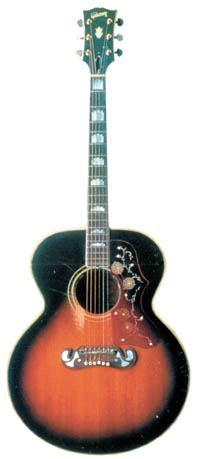
Pete’s 1968 Gibson J-200.
The guitar that made Pete’s defining acoustic sound on record. Pete wrote Pinball Wizard on this guitar and created the genre-defining acoustic percussive rhythm sound heard on most all recordings beginning with Tommy.
Pete purchased this guitar new from Henry Goldrich at Manny’s Music in New York in 1968, while he was working on the songs that would become Tommy.
The guitar disintegrated in 1989 and was restored. Pete donated the original guitar to the Rock and Roll Hall of Fame in Cleveland, Ohio, in June 1993.
General 1968 Gibson J-200 features
- Spruce top, round soundhole.
- Black pickguard with engraved floral pattern.
- Figured maple back, sides and neck.
- 14/20-fret bound rosewood fingerboard with pearl crown inlay.
- Rosewood “closed” moustache bridge with pearl block inlays, black pearl dot pins; Tune-o-matic adjustable metal bridge.
- Bound peghead with pearl plant/logo inlay, three-per-side gold Grover tuners with pearl buttons.
- Vintage Sunburst finish.
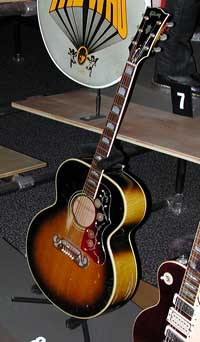
Click to view larger version. Pete’s original 1968 Gibson J-200 on display at Rock & Roll Hall of Fame, Cleveland, Ohio.
Pete’s use of the Gibson J-200
Pete used this guitar for writing and recording on virtually everything beginning in 1968 until 1989’s Iron Man. He brought the original Gibson J-200 with him everywhere until 1979, at which time he acquired his first small-bodied Fylde Ariel guitar. At some point around or after 1979, he acquired at least one additional sunburst Gibson J-200, a model from 1955–1961, with open “moustache” bridge, which was used for studio work (see photo at bottom). Around 1989 (Iron Man era), Pete switched to using Takamines and other acoustic guitars in the studio, at which time the original Gibson J-200 deteriorated (see story, below), though was subsequently repaired. With the opening of the Rock and Roll Hall of Fame in Cleveland, Ohio, Pete donated this guitar, where it is on display at present.
Recent use of Gibson J-200 guitars
With the Who and solo activity starting in 1996, Pete acquired numerous non-vintage blonde (Antique Natural Lacquer) Gibson J-200 guitars fitted with Fishman Acoustic Matrix pickup systems for use in stage and studio activity, which he has continued to use to this day.
Signature model
In February 2004, Gibson has issued a Gibson Pete Townshend SJ-200 Limited in commemoration of Pete’s Gibson J-200.
Selected quotes from Pete Townshend
All quotes and references are copyright their original owners and are included for reference only.
From April 1980 issue of Sound International article, courtesy Joe G’s site.
I came to Manny’s again and told Henry [Goldrich] I wanted a J-200 and he brought out 20 brand new and I tried all of them and I found one superb, which I still have.
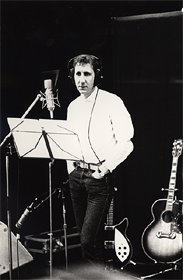
Ca. 1981, in the studio, with the original 1968 Gibson J-200 and 1964 Rickenbacker 330S/12.
From September 1989 Guitar Player article.
- Guitar Player: Since Tommy, the acoustic guitar has provided a sonic cushion for almost everything you’ve recorded, no matter how bombastic the context, and the new album is pervaded by that cushion. But I detect that this record is the first time you’ve ever recorded without your Gibson J-200 since 1969.
PT: [Smiling] That’s correct, yeah. This is a weird thing about guitars and musical instruments. You know, I’ve smashed so fucking many guitars, and always maintained that they’re just planks of wood, and, “Don’t give me that shit about guitars with all that ‘it knows when I’m away’ stuff,” but because I hardly used it on this record at all, it died! It was in the studio waiting in its case, and I went back to do some work there with Boltz, the other guitarist. I opened the case and picked it up, and it had just completely fallen to bits. The strings had corroded to an extraordinary extent, the frets had grown mold, the bridge had come off, the back had popped open, and all of the top had delaminated. And yet, while I was working on the demos before I went into the studio, it worked perfectly well. It’s almost like once it knew it was not going to be on the record, it just went bing! I had it rebuilt, and I’m going to have to take it home and play it. It’s like a different guitar now, like a new guitar.
From August 1994 Guitarist magazine interview with Steve ‘Boltz’ Bolton
So I went over to Eel Pie and met him. Pete asked one of his engineers to get his Gibson J200 and when he opened the case the guitar just snapped: the bridge flew off! … I said, See that Pete; you just look at a guitar and it just smashes itself up! This must tell you something!
From June 1990 Guitarist magazine article
I don’t have romantic misconceptions about musical instruments — they’re just wood, probably far more useful as pulp than anything else. There are actually a couple of instruments that I would miss, and in fact a weird thing happened to the J-200 that I’ve had for a long time. Half way through ‘Iron Man’ it got wet in the studio and exploded, and it was almost like the guitar getting back at me — the only guitar I cared about dying on me!”
From May 17, 2004, Gibson Guitars interview: J-200s, regrets over smashed guitars, The Who ‘Then and Now’ and more: Q&A with Pete Townshend
- What’s the story on your original J-200? What is it about a J-200 that makes it so essential to you?
I picked it out from about five at Manny’s in New York. It had a crisp sound and an easy neck. It was only later I found how well the J-200 records when you play it hard. Like the Everly acoustic, it has a rather dead soundboard and that allows you to really dig in when strumming. They are hard to bring to life with piezo pickups because the sound is so distinctive in real air, but the body shape, the necks and the sheer strength of the guitar are all very important to me. They also look utterly beautiful.
From September 2004, 20th Century Guitars interview: The Music Must Change
- Could you say something about the Pete Townshend J-200 limited guitar that Gibson recently introduced? ... The Pete Townshend signature model has ... a lighter neck contour. How involved were you in designing the new J-200 signature?
I did a lot of work on the neck. My very first J200 seemed to have a thinner neck.
- What originally attracted you to the Gibson Super Jumbo 200? I know that Elvis, Dylan and Ron Wood used it.
It records so well. It has quite a crisp sound for such a large guitar, and my first one (now in the Rock and Roll Hall of Fame Museum) actually had a metal tunamatic bridge. I may try this on a variant of my signature model.
Photo Gallery
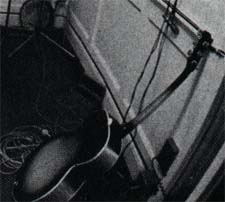
Home studio, ca. 1969.
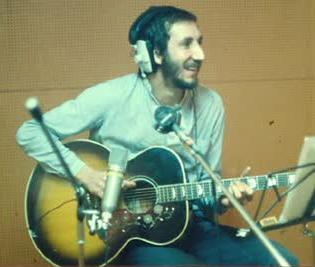
Ca.1976/77, at Olympic Studios, recording Rough Mix.
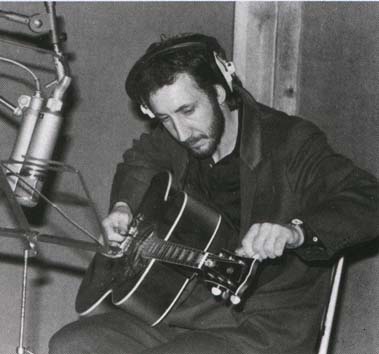
Non-original Gibson J-200.

Non-original Gibson J-200.
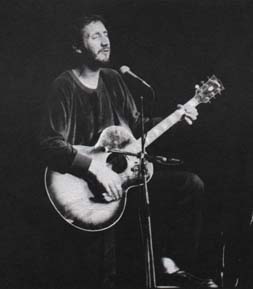
Unplugged. Onstage at the Secret Policeman’s Ball, 1979, with the original 1968 Gibson J-200, where he performed Pinball Wizard, Drowned and Won’t Get Fooled Again.
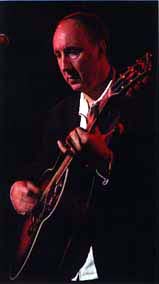
Ca. 1996, solo show, with non-original sunburst Gibson J-200.
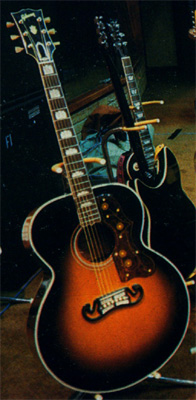
In the studio, ca. 1981, with alternate Gibson J-200, a 1955-1961 model.
Resources and Information
Acknowledgements
Thanks to Brad Rodgers (whocollection.com) for assistance with this page.
For more information:
- Vintage Guitars Info: guitarhq.com/gibson6.html
- Manny’s Music, New York: mannysmusic.com
Manufacturer:
- Gibson USA: gibson.com